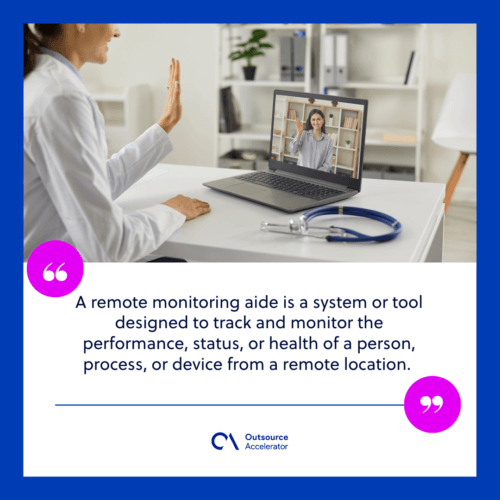Benefits and challenges of implementing a remote monitoring aide

Technology has revolutionized how industries operate. One such advancement is the implementation of remote monitoring aides, particularly in healthcare, manufacturing, and logistics.
These tools allow for real-time monitoring of systems, patients, or processes from a distance, offering the potential for greater efficiency and improved outcomes.
However, like any technological solution, the remote monitoring aide comes with its own set of benefits and challenges.
In this article, we will explore what a remote monitoring aide is, its key advantages, challenges, and whether it is the right choice for your business or organization.
What is a remote monitoring aide?
A remote monitoring aide is a system or tool designed to track and monitor the performance, status, or health of a person, process, or device from a remote location.
These aides use a combination of sensors, data analytics, and communication networks. They can deliver real-time information to prompt decision-making and action.
In healthcare, for instance, remote monitoring aides track patients’ vital signs. Meanwhile, in industrial settings, they can monitor the functioning of machines and equipment.
With advancements in artificial intelligence (AI) and the Internet of Things (IoT), remote monitoring aides have become more sophisticated. Based on the data they collect, they can provide actionable insights.
The ability to monitor remotely can drastically improve efficiency, reduce costs, and ensure timely interventions in various sectors.

5 benefits of a remote monitoring aide
Implementing a remote monitoring aide provides numerous and impactful advantages across industries, including the following:
1. Improved efficiency and proactive intervention
Remote monitoring aides allow organizations to track systems and individuals in real-time. This makes it easier to detect problems before they escalate.
Continuous patient monitoring can alert healthcare providers to potential issues, which enables early interventions.
Equipment performance can be tracked in industrial settings to prevent costly breakdowns. This proactive approach reduces downtime, improves efficiency, and leads to better outcomes.
2. Cost savings
Remote monitoring aides can help save costs in multiple ways.
Remote monitoring lessens the need for hospital stays or visits for healthcare providers. Patients can get care while staying in their own homes.
This not only saves on medical costs but also reduces strain on healthcare systems.
Remote monitoring helps prevent expensive equipment failures and maintenance costs by identifying problems early on. Industrial settings avoid larger repairs or replacements.

3. Better resource management
With remote monitoring aides, organizations can better allocate resources.
For example, healthcare providers can focus more attention on patients who require immediate care. Conversely, stable patients can be monitored remotely.
In businesses, remote monitoring aides can provide insights into which machines or processes are underperforming. This allows resources to be directed more efficiently.
4. Enhanced data collection and analytics
Another key advantage of remote monitoring is the ability to collect large volumes of data over time. The information can be analyzed to:
- Spot trends
- Predict future issues
- Improve decision-making
In healthcare, data from remote patient monitoring can help track long-term health trends. While in manufacturing and supply chains, it can highlight inefficiencies or areas where improvements can be made.
5. Access to remote or hard-to-reach areas
Remote monitoring aides are particularly valuable in situations where it is difficult or costly to have personnel on-site.
For healthcare providers, this means being able to offer care to patients in remote areas who might not have easy access to hospitals or clinics.
Similarly, in industries such as oil and gas, monitoring remote locations is necessary. Remote monitoring aides offer a practical solution.
Challenges of a remote monitoring aide
While the benefits of remote monitoring aides are significant, they also come with challenges that organizations must consider before implementation:
1. Technological infrastructure and reliability
Remote monitoring systems rely heavily on internet connectivity and cloud-based services. In areas with poor connectivity or unstable internet, this can pose a significant barrier to implementation.
Additionally, technical malfunctions or software glitches can disrupt real-time monitoring, leading to delays or inaccuracies in data.
2. Data security and privacy concerns
Remote monitoring aides collect vast amounts of sensitive data, particularly in healthcare. This presents a challenge in terms of ensuring data security and privacy.
Breaches in data security could not only lead to significant legal repercussions but also erode trust between service providers and users.
3. User training and adoption
The success of a remote monitoring aide depends heavily on the willingness and ability of users to engage with it.
Resistance to change or lack of proper training can result in the underutilization of these aides.
4. Initial setup and ongoing maintenance costs
Remote monitoring aides can result in long-term cost savings. However, the initial investment in technology can be high, as the installation of sensors, software, and communication networks requires substantial upfront costs.
Moreover, organizations need to budget for ongoing maintenance and technical support to ensure that the system functions smoothly.

Should you implement a remote monitoring aide?
Deciding whether to implement a remote monitoring aide depends on factors like your organization’s needs, budget, and capacity to overcome potential challenges.
Consider whether your organization requires real-time monitoring, especially if you work in remote or high-risk areas. The benefits of efficiency, cost savings, and data insights may outweigh the initial investment and technical challenges.
However, before proceeding, first ensure that your organization has the technological infrastructure, a secure data management system, and a plan for user training and support.
When implemented correctly, a remote monitoring aide can be transformative, but it requires careful planning and consideration to be truly effective.







 Independent
Independent




